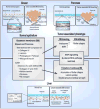Force-dependent breaching of the basement membrane
- PMID: 28025167
- PMCID: PMC5328923
- DOI: 10.1016/j.matbio.2016.12.005
Force-dependent breaching of the basement membrane
Abstract
Clinically, non-invasive carcinomas are confined to the epithelial side of the basement membrane and are classified as benign, whereas invasive cancers invade through the basement membrane and thereby acquire the potential to metastasize. Recent findings suggest that, in addition to protease-mediated degradation and chemotaxis-stimulated migration, basement membrane invasion by malignant cells is significantly influenced by the stiffness of the associated interstitial extracellular matrix and the contractility of the tumor cells that is dictated in part by their oncogenic genotype. In this review, we highlight recent findings that illustrate unifying molecular mechanisms whereby these physical cues contribute to tissue fibrosis and malignancy in three epithelial organs: breast, pancreas, and liver. We also discuss the clinical implications of these findings and the biological properties and clinical challenges linked to the unique biology of each of these organs.
Keywords: Breast cancer; Hepatocellular carcinoma; Matrix rigidity; Pancreatic cancer; Tumor invasion.
Copyright © 2017 International Society of Matrix Biology. Published by Elsevier B.V. All rights reserved.
Figures



References
Publication types
MeSH terms
Substances
Grants and funding
LinkOut - more resources
Full Text Sources
Other Literature Sources
Medical

